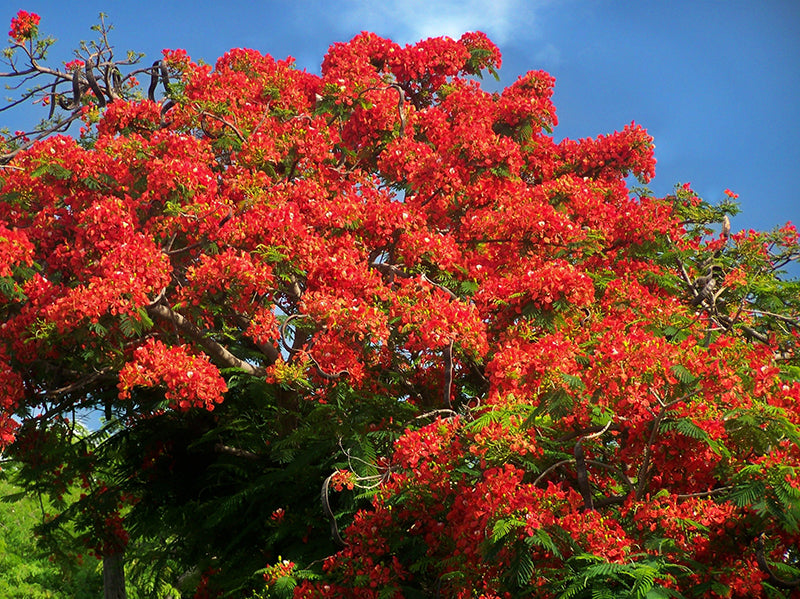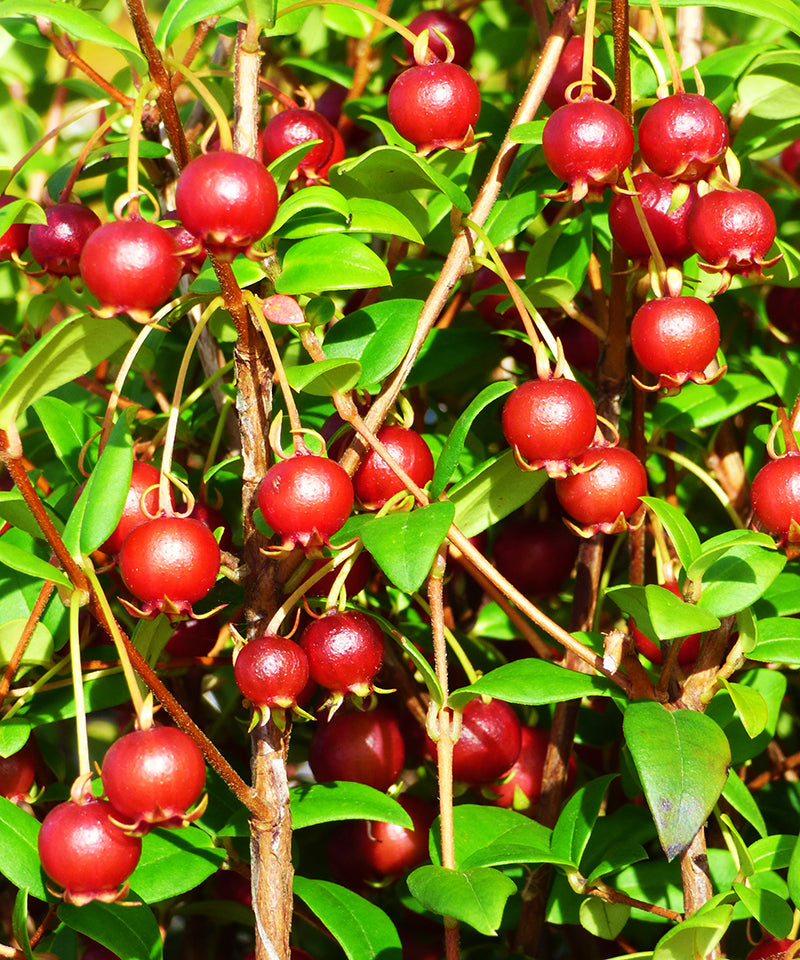It’s hard to say where a person derives a preference for one plant over another because there are so many factors at play. Some involve place and time, while others are simply a matter of the senses: visually beautiful leaves, seeds or flowers, or a distinct fragrance that instantly triggers that memory of first encounter. Be that as it may, here are ten of my favourite plants from different parts of the world, although this is hardly a comprehensive list of my best-loved flora.
Davidia involucrata Plant from China

My first encounter with this rare tree from China came at the beginning of my horticultural career while working as a gardener on the Whithall estate, an old garden established in the 1930’s that is located in Whonnock. It was a mature specimen that was smothered in blooms, which meant that it was strewn with pairs of pure white bracts resembling leaves, which is where its common names are derived, including Dove Tree, Pocket Handkerchief Tree, and Ghost Tree. It is named after the French naturalist Pere Armand David and it is the only living species in the Davidia genus, with fossils of extinct species still found in Alberta. You will have to exercise some patience with this tree, as it can take up to 10 years for a juvenile to produce bloom bracts. It has a broadly pyramidal form, growing 40-50’ tall and is hardy to USDA zone 6.
Arum italicum Plant from Italy
 This tuberous perennial can be a little hard to find but the combination of beautifully marbled foliage and unusual red, orange, and green berry spikes make it worth the search. Commonly known as Italian Lords and Ladies, you want the AGM winning ‘Marmoratum’ or ‘Pictum’ cultivar, as the foliage is much more intricate. Expect rather boring creamy-white spathes from April to May, with the leaves going summer dormant shortly afterwards (returning with the fall rains), leaving only the show-stopping stemmed berry clusters. It prefers shade to partial shade, grows 12-18” tall, and is hardy to USDA zone 5.
This tuberous perennial can be a little hard to find but the combination of beautifully marbled foliage and unusual red, orange, and green berry spikes make it worth the search. Commonly known as Italian Lords and Ladies, you want the AGM winning ‘Marmoratum’ or ‘Pictum’ cultivar, as the foliage is much more intricate. Expect rather boring creamy-white spathes from April to May, with the leaves going summer dormant shortly afterwards (returning with the fall rains), leaving only the show-stopping stemmed berry clusters. It prefers shade to partial shade, grows 12-18” tall, and is hardy to USDA zone 5.
Ribes sanguineum Plant from British Columbia
 This is one of our first native shrubs to come into bloom starting in early spring, from March into May. The showy rose-pink bloom clusters are abundant (even on juvenile plants) and readily attract overwintering Anna’s hummingbirds and the Rufous returning from their migration south. Prune to size after flowering and plant in part to full sun for the best bloom display. Grows 8-10’ tall without pruning. Hardy to USDA zone 6.
This is one of our first native shrubs to come into bloom starting in early spring, from March into May. The showy rose-pink bloom clusters are abundant (even on juvenile plants) and readily attract overwintering Anna’s hummingbirds and the Rufous returning from their migration south. Prune to size after flowering and plant in part to full sun for the best bloom display. Grows 8-10’ tall without pruning. Hardy to USDA zone 6.
Gunnera manicata Plant from Brazil
 My first experience with this species was at the aforementioned Whithall estate, where they were used extensively to line stream banks to great effect. While we had the room for mass planting at that scale, average homeowners should be aware that this is a very large perennial, with solitary leaves capable of reaching a 7-8’ spread. The prickly stems and pink-toned flowers lend a Jurassic-look, but because this plant hails from Brazil, some winter protection is required. Wait until the frost begins to brown the leaf edge, then cut off the leaves and stems separately (a machete works well), piling the leaves upside down in layers over the crown and laying the remaining stems overtop to keep them in place. Even soil moisture is also necessary. Grows 10’ tall by 14’ wide and hardy to USDA zone 7.
My first experience with this species was at the aforementioned Whithall estate, where they were used extensively to line stream banks to great effect. While we had the room for mass planting at that scale, average homeowners should be aware that this is a very large perennial, with solitary leaves capable of reaching a 7-8’ spread. The prickly stems and pink-toned flowers lend a Jurassic-look, but because this plant hails from Brazil, some winter protection is required. Wait until the frost begins to brown the leaf edge, then cut off the leaves and stems separately (a machete works well), piling the leaves upside down in layers over the crown and laying the remaining stems overtop to keep them in place. Even soil moisture is also necessary. Grows 10’ tall by 14’ wide and hardy to USDA zone 7.
Tulipa tarda Plant from Turkey
 This diminutive species from Turkey best lends itself to small rockeries or displays closer to walkways or patios where it can be appreciated. Tulipa tarda naturalizes very well as long as you ensure that winter drainage is adequate and allow the foliage to fade before cutting. You can expect cheery bright yellow flowers with prominent white tips from early to mid-spring. Grows 4-6” tall and hardy to USDA zone 3.
This diminutive species from Turkey best lends itself to small rockeries or displays closer to walkways or patios where it can be appreciated. Tulipa tarda naturalizes very well as long as you ensure that winter drainage is adequate and allow the foliage to fade before cutting. You can expect cheery bright yellow flowers with prominent white tips from early to mid-spring. Grows 4-6” tall and hardy to USDA zone 3.
Dracunculus vulgaris Plant from Greece
 Voodoo Lily lives up to its name bearing prominent unearthly purple spathes with a noteworthy, but somewhat obscene, deep maroon spadix protruding in all its phallic innuendo. The bloom emits a distinct ‘outhouse’ aroma, as it is meant to attract flies and beetles as pollinators. Intricately cut foliage and beautifully mottled stems also add to the overall appeal, but this species does go summer dormant. Grows 2-4’ tall and hardy to USDA zone 7.
Voodoo Lily lives up to its name bearing prominent unearthly purple spathes with a noteworthy, but somewhat obscene, deep maroon spadix protruding in all its phallic innuendo. The bloom emits a distinct ‘outhouse’ aroma, as it is meant to attract flies and beetles as pollinators. Intricately cut foliage and beautifully mottled stems also add to the overall appeal, but this species does go summer dormant. Grows 2-4’ tall and hardy to USDA zone 7.
Delonix regia Plant from Madagascar
 I thought I would throw in a tropical species, as this Madagascar native has been naturalized over many of our favourite vacation spots, including Hawaii. Royal Poinciana features an elegant sweeping horizontal growth habit and dazzling reddish-orange blooms that really stand out in the distance, which somewhat resemble Alstroemeria at closer inspection. My favourite aspect of this species is the substantial 12-24” long seedpods, a pair of which currently reside in my den. Delonix regia is hardy to USDA zone 10.
I thought I would throw in a tropical species, as this Madagascar native has been naturalized over many of our favourite vacation spots, including Hawaii. Royal Poinciana features an elegant sweeping horizontal growth habit and dazzling reddish-orange blooms that really stand out in the distance, which somewhat resemble Alstroemeria at closer inspection. My favourite aspect of this species is the substantial 12-24” long seedpods, a pair of which currently reside in my den. Delonix regia is hardy to USDA zone 10.
Sarracenia psittacina Plant from Florida
 I love all Pitcher plants but this species from Florida has ominous-looking hoods that somewhat resemble a cobra’s head. These evergreen perennials are also quite beautiful with their bright red, white, and green pitchers and prominent 2” wide burgundy flowers that stand well above the foliage. Grows 6” tall and hardy to USDA zone 7.
I love all Pitcher plants but this species from Florida has ominous-looking hoods that somewhat resemble a cobra’s head. These evergreen perennials are also quite beautiful with their bright red, white, and green pitchers and prominent 2” wide burgundy flowers that stand well above the foliage. Grows 6” tall and hardy to USDA zone 7.
Ugni molinae (Chilean Guava) Plant from Chile
 Here’s a plant that smells as good as it tastes. When those delicious red berries ripen in the fall, the aroma is mouthwatering. Expect a unique strawberry-guava flavour that works well in muffins or fruit salads. It's irresistible to children! This evergreen shrub is a bit tender but I grow mine in a container and cover it temporarily with a protective sleeve when the temperature drops below freezing. The large white heather bells are produced from late spring into summer and contrast nicely against the fine, dark green leaves. Strawberry Guava is self-fertile and a variegated form, ‘Flambeau’, is also available. Grows 3-6’ tall in Canada and hardy to USDA zone 8.
Here’s a plant that smells as good as it tastes. When those delicious red berries ripen in the fall, the aroma is mouthwatering. Expect a unique strawberry-guava flavour that works well in muffins or fruit salads. It's irresistible to children! This evergreen shrub is a bit tender but I grow mine in a container and cover it temporarily with a protective sleeve when the temperature drops below freezing. The large white heather bells are produced from late spring into summer and contrast nicely against the fine, dark green leaves. Strawberry Guava is self-fertile and a variegated form, ‘Flambeau’, is also available. Grows 3-6’ tall in Canada and hardy to USDA zone 8.
Amaranthus tricolor Plant from India
 You might think that this summer flower is all about its beautiful foliage but it is also quite edible, with the cooked leaves being a staple in many countries. The jarring red, yellow, green, and sometimes purple foliage will not be ignored in any garden scenario, although it does prefer a full sun exposure. Also known as Joseph’s Coat, it can be hard to find as a bedding plant but seeds are readily available. Grows about 2-4’ tall and dies with a hard frost.
You might think that this summer flower is all about its beautiful foliage but it is also quite edible, with the cooked leaves being a staple in many countries. The jarring red, yellow, green, and sometimes purple foliage will not be ignored in any garden scenario, although it does prefer a full sun exposure. Also known as Joseph’s Coat, it can be hard to find as a bedding plant but seeds are readily available. Grows about 2-4’ tall and dies with a hard frost.
All images Copyright 2023 MK Lascelle


